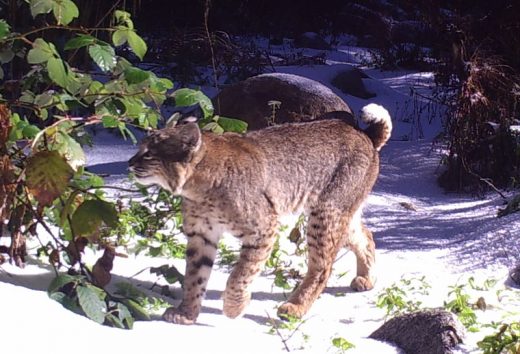
Photo courtesy James Reserve
Over the last several months the entries for the “Journal from the James” have included periodic accounts on the results of our trail camera efforts around town. The project, “What’s Wild in Idyllwild,” was an attempt to document the common and not-so-common wildlife species that share the mountain retreat we call home.
We put our first cameras out in February 2015 and with the generous cooperation of many homeowners in Idyllwild, Fern Valley and Pine Cove, we were able to set up cameras in a variety of areas, from the edge of the towns to well within their boundaries. It is through these homeowners’ cooperation that we were able to amass well over 5,000 photos of 11 species of mammals and 15 species of birds.
Over this length of time and so many photos, we feel we have a pretty good picture of the type of wildlife that normally roam among us. And so, we have decided to officially end the field portion of the project and to publicly extend our warmest thanks to all who participated. Though the analysis of the photos will go on for some time more, I would like to also take this opportunity to summarize what we found regarding what is wild in Idyllwild.
Of the 26 different species we recorded, the number of photos taken of each species varied from just a few to over a 1,000. The rarest species of mammal, with only four photos, was the mountain lion. We captured photos of this elusive animal along Strawberry Creek and in Fern Valley.
There was a virtual tie between gray squirrels and deer as to the most photographed species of mammal, with more than 1,300 photos of each. They were also the most widely distributed, showing up on almost all of the 15 cameras we had set out.
Besides the mountain lion, one of the surprises from the photos was how often bobcats showed up, with more than 200 photos. Though they were photographed in six different areas, the majority of the photos were of one photogenic animal that lived along Strawberry Creek.
Although there were fewer total numbers of photographs taken of birds, like the mammals, the number of photos of birds were concentrated in a few species. The most photos taken (406) were of band-tailed pigeons and most of those (353) were from one yard. This species tends to move in large flocks, which can account for the high numbers in one area.
Other commonly photographed birds included ravens, Steller’s jays and California quail. The most widely distributed bird species was the Steller’s jay showing up in seven of the 15 sites.
For the species in which we had abundant photos, we were able to estimate their general activity patterns based on the time the photos were taken. Many mammals can be active both during the day and night but each species does seem to confine their activity during specific time periods.
The grey fox was the most nocturnal of the mammals, with 100 percent of the photos being taken after sunset and before sunrise. Others, like bobcats and coyotes, were more what we call crepuscular or active primarily around sunrise and sunset. Deer seemed to be active at all times of the day and night while gray squirrels were active only during the daylight hours.
Although most birds are strictly active during the daytime, even during that time, they had routines of activity. Band-tailed pigeons commonly are more active in the early morning hours, as were the mountain and California quail. In contrast, ravens and crows were “midday” critters, being more active between 11 a.m. and 1 p.m.
So apart from this brief summary here, what do I plan to do with all this information? I think beyond what I can present in this limited space, the people of Idyllwild would be interested in what we found.
The plan is to develop all this information into an informational book titled, not surprisingly, “What is Wild in Idyllwild!” This book will contain more detailed descriptions of the 26 species, including information on where they were found in the area, their natural history, their behavior and, of course, photographs taken by the cameras. I hope to develop this book over the next year and if anyone is interested in supporting this effort, you can contact me via email at launjohn@hotmail.com.
In ending, I have to inform you that not only does this article signal the end of the trail-camera project, but also my contributions to the “Journal of the James.” I will be moving on from here but will fondly remember my interactions with the people associated with this project and the pleasure of being able to contribute to the “Journal of the James.” I hope that the readers have found what I have written to be interesting and informative.
Editor’s note: We will miss John’s contributions to this column as he leaves his position at the James Reserve and the San Jacinto Mountains. Hopefully, Dr. Jennifer Gee, James director, can continue the column and replace John with someone equally capable as assistant director there.




